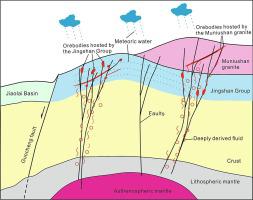Ore Geology Reviews ( IF 3.3 ) Pub Date : 2021-09-02 , DOI: 10.1016/j.oregeorev.2021.104449 Jinghua Wu 1, 2 , Yuanlin Chen 1 , Chaoyang Zheng 3 , Huan Li 1 , Kotaro Yonezu 2 , Yuyu Tang 1 , Qi Zong 1

|
The Jiaodong Peninsula in eastern China hosts numerous large and giant gold deposits. Recently, a set of gold deposits distributed along the Guocheng Fault have been identified as a new gold mineralization type, of which the Longkou–Tudui gold deposit is spatially associated with the Muniushan monzogranite whereas its genesis is poorly constrained. A systematic study including zircon U-Pb dating, fluid inclusions, C–H–O–S stable isotopes was carried out in order to determine the genesis of the Longkou–Tudui gold deposit. Zircon dating results indicate that the Muniushan monzogranite and dioritic porphyrite were emplaced at 2089–2066 Ma (with a metamorphism probably occurring at 1860 ± 27 Ma, MSWD = 0.98) and 115.6 ± 1.4 Ma, respectively. Combined with cross-cutting relationships of the Muniushan monzogranite, dioritic porphyrite, and gold orebodies, it is inferred that the gold mineralization occurred in the early Cretaceous. Fluid inclusion study demonstrates a H2O–NaCl ± CO2 system, with a progressive decrease in average values of homogenization temperature and salinity from pre-ore to post-ore stages but a slight increase in bulk density. The ore-forming fluid is characterized by reductive, acidic, high to middle temperature, low salinity, and low density as revealed by a combined study on fluid inclusion and stable isotopes. H–O–C–S isotopic compositions indicate that the ore-forming materials have multiple sources including an inherited S source from the Jingshan Group, a mantle-derived C source, and a mixed H–O source induced by the addition of meteoric water. Compared with other Jiaodong gold deposits, the Longkou–Tudui deposit does not differ in mineralization age, nature and evolution of ore-forming fluid, and source of ore-forming materials except for orebody occurrence and heavier δ34S values inherited from the Jingshan Group, and this deposit was a byproduct of oceanic subduction of the Paleo Pacific Ocean.



























 京公网安备 11010802027423号
京公网安备 11010802027423号